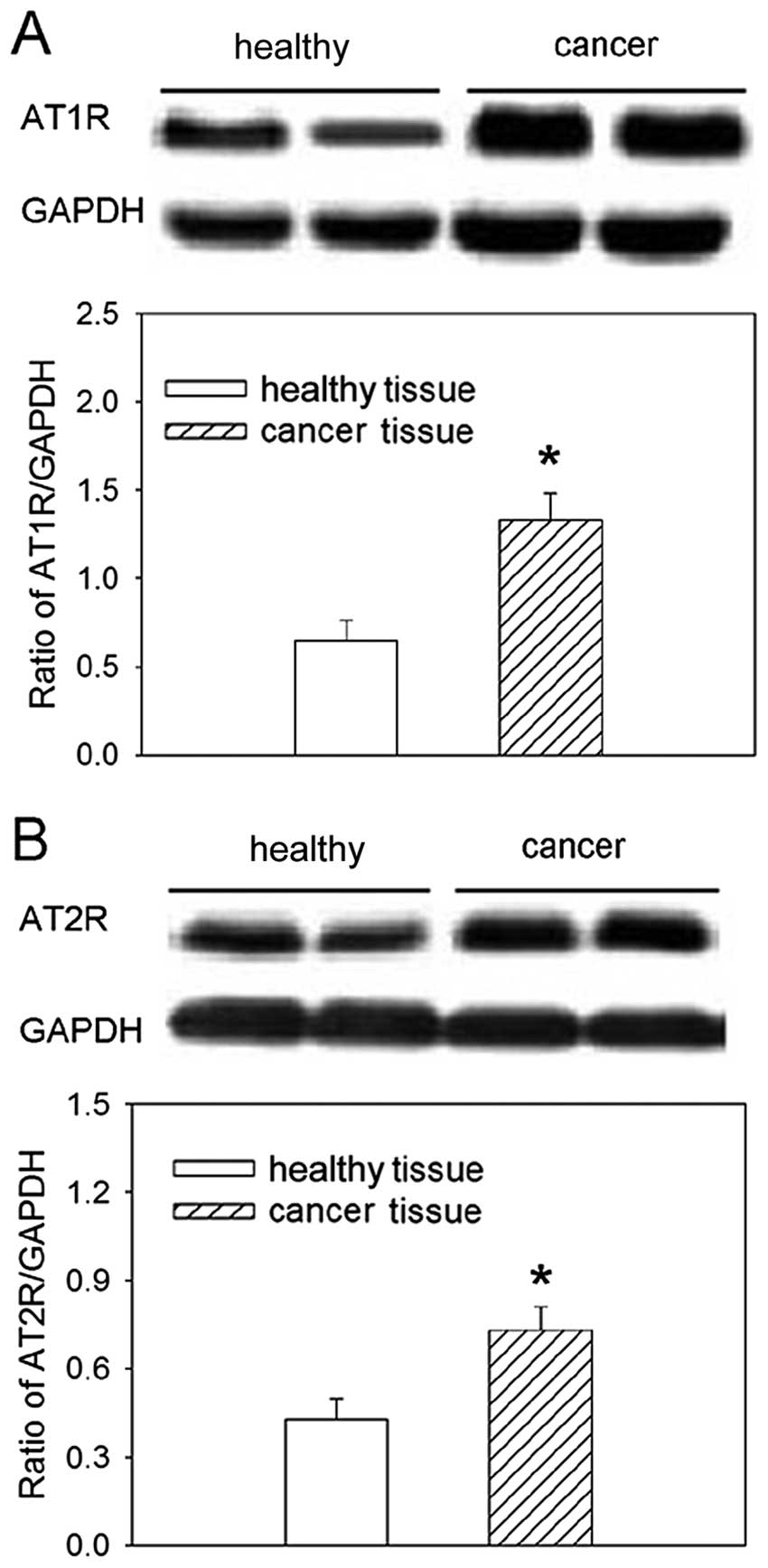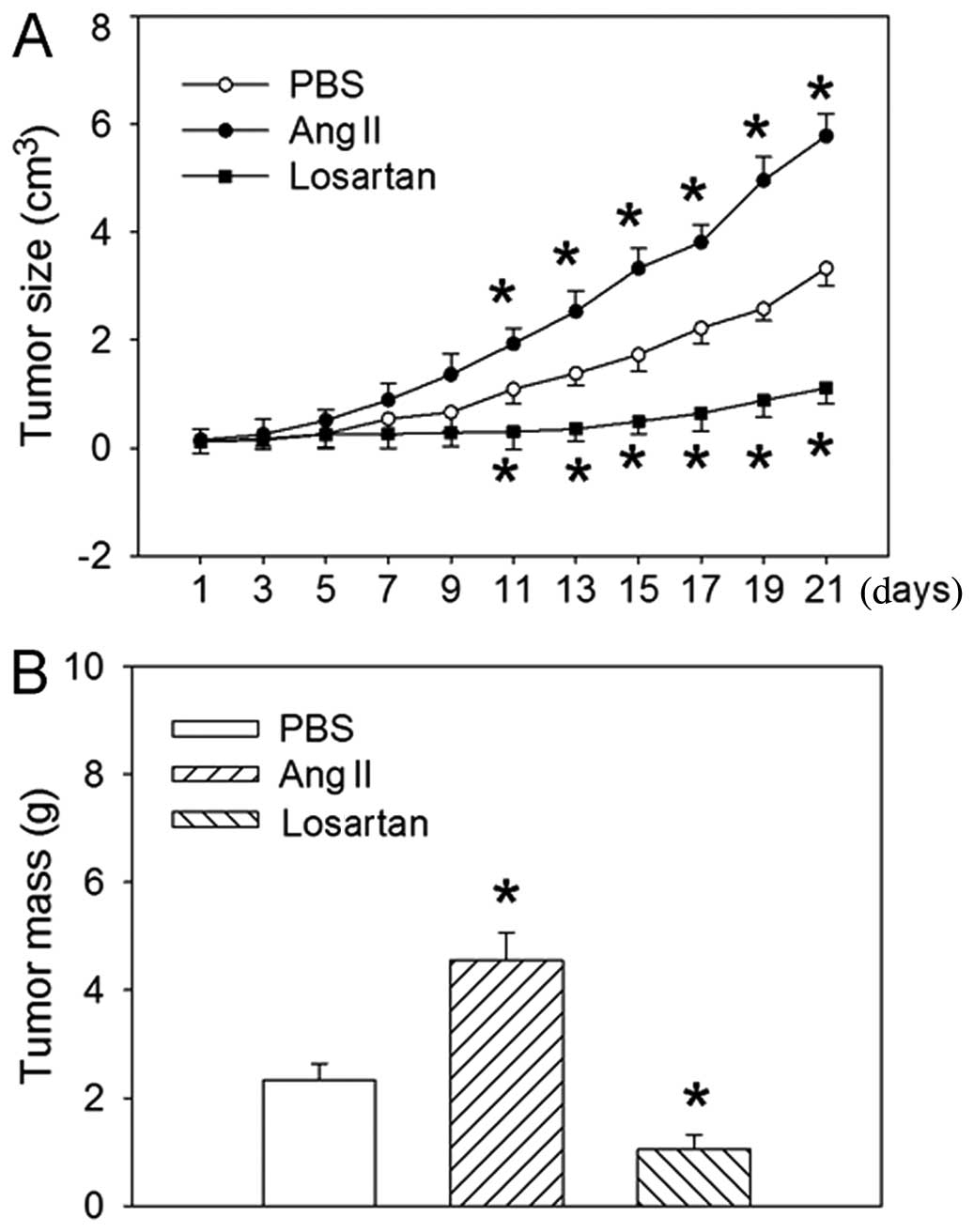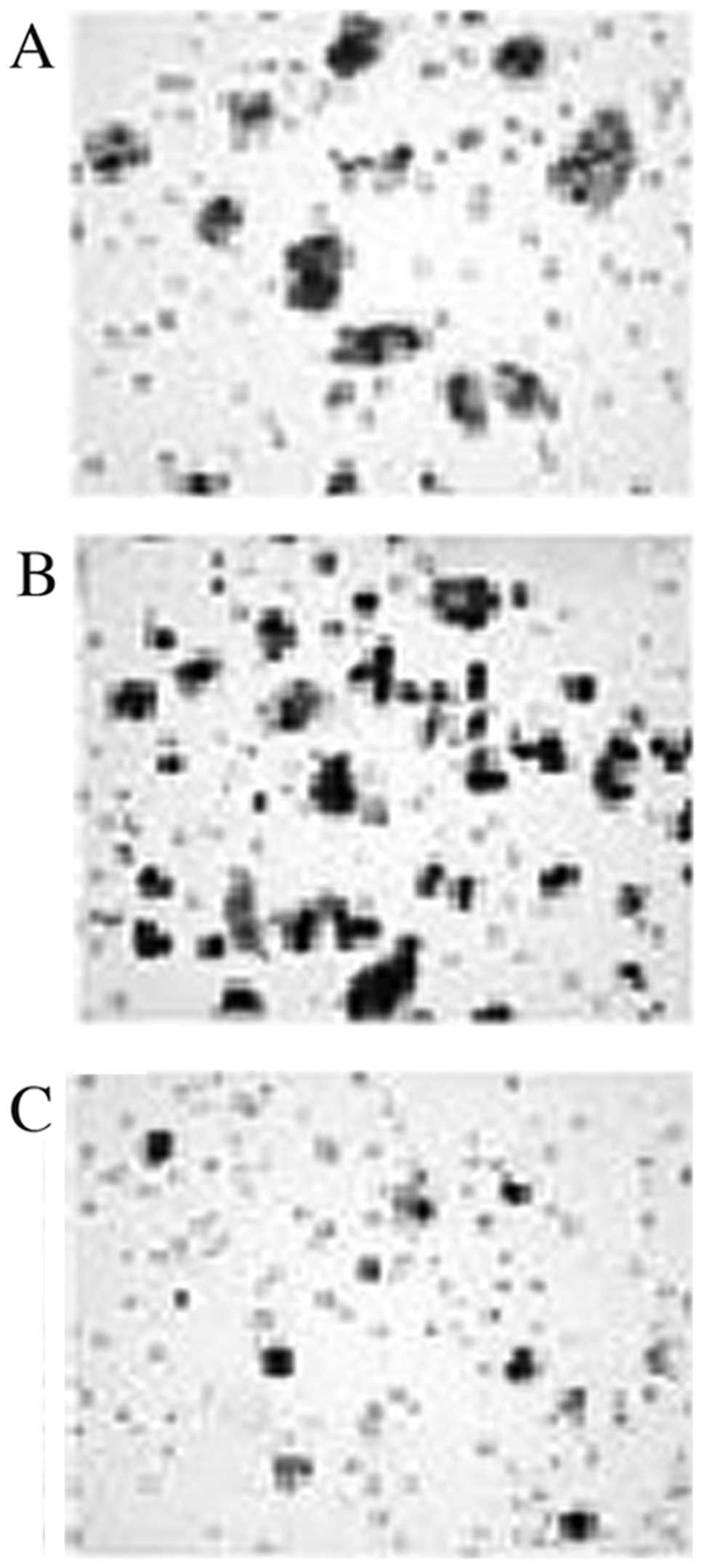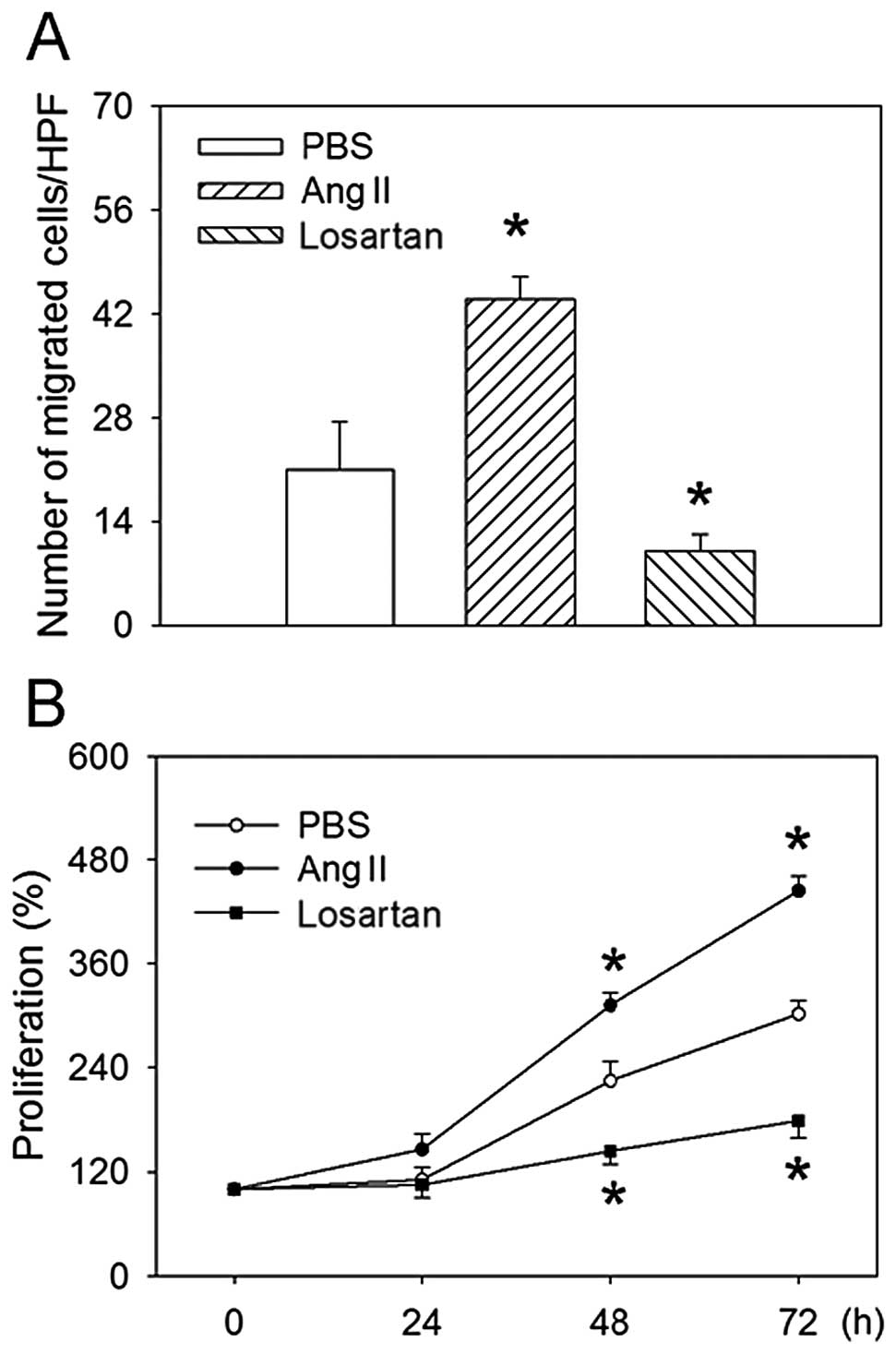Angiotensin II promotes the progression of human gastric cancer
- Authors:
- Published online on: January 10, 2014 https://doi.org/10.3892/mmr.2014.1891
- Pages: 1056-1060
Abstract
Introduction
Cancer is a major health issue worldwide and the second leading cause of death after cardiovascular diseases (1). Gastric cancer is one of the most common cancer types, commonly diagnosed in advanced stages where curative treatment is ineffective (2). Genetic factors (oncogenes and genes coding for inflammatory cytokines), infection (hepatitis virus, Helicobacter pylori and Epstein-Barr virus) and environmental factors (alcohol, salt intake and smoking) may contribute to gastric cancer (3–7).
Self-sufficiency of growth signals and metastasis are hallmark alterations in cell physiology associated with cancer (8), and involve unlimited proliferation, subsequent dissociation of tumor cells from the primary tumor and eventually, invasion of adjacent tissues. It has been shown that microRNAs (9,10) and genes coding for the estrogen receptor (ER)α (11) and ghrelin (12) are involved in the migration and proliferation of gastric cancer cells. However, the mechanisms underlying these events remain unclear.
The renin-angiotensin system (RAS) consists of renin, angiotensinogen, angiotensin (Ang), and the angiotensin-converting enzyme (ACE). RAS influences cardiovascular homeostasis and is associated with cardiovascular diseases such as heart failure and hypertension (13,14). A major regulatory component of RAS is Ang II, a biologically active peptide that is involved in the regulation of cell proliferation, angiogenesis, inflammation, and tissue remodeling via binding to the Ang II type 1 receptor (AT1R) (15–17). An association between RAS function and gastric cancer has been shown in a number of studies (18–20). It was previously shown that ACE, AT1R and AT2R are upregulated in tumor tissues (18). Gastric mucosal ATR expression was also shown to gradually increase during the course of H. pylori infection; RAS activation during the progression of gastric inflammation supports its potential involvement in gastric carcinogenesis (19). Moreover, local production of Ang II in gastric cancer cells is involved in cell proliferation and survival (20). However, the relationship between Ang II and gastric cancer is not well understood.
The present study was designed to determine the roles of Ang II in the growth of gastric cancer cells in male nude mice and in the migration and proliferation of MKN45 human gastric cancer cells.
Materials and methods
Tissue specimens
Twenty gastric cancer and corresponding normal gastric mucosa tissue samples (>10 cm away from the edge of the cancer) were obtained from gastric cancer patients, snap-frozen in liquid nitrogen and stored at −80°C until use. All the patients had undergone preoperative clinical staging assessment with endoscopic ultrasonography and multislice spiral computed tomography and had not received chemotherapy or radiotherapy prior to surgery.
Animals and gastric cancer model
Male BALB/c nude mice (4–6 weeks old, 15–20 g average weight) were purchased from the Chinese Academy of Medical Sciences Laboratory Animal Center. The mice were housed in a temperature- and humidity-controlled room with a 12-h on-off light cycle and were given free access to food and water. To establish the gastric cancer mouse model, 100 μl MKN45 gastric cancer cells in phosphate-buffered saline (PBS; 5×107 cells/ml) were intraperitoneally injected into the nude mice, as previously described (21). Normotensive sham-operated mice (PBS group) underwent a similar surgical process, except for the injection of gastric cancer cells. Tumor size was calculated as previously described (22): length × width × depth × 0.5236.
Cell lines and cell culture
MKN45 human gastric cancer cell lines were purchased from the Cancer Institute of the Chinese Academy of Medical Sciences (Beijing, China). The cell lines were cultured in phenol red-free Dulbecco’s modified Eagle’s medium (DMEM) supplemented with 10% charcoal-stripped fetal bovine serum (FBS) (both from Invitrogen Life Technologies, Carlsbad, CA, USA) ), 100 U/ml penicillin and 100 U/ml streptomycin, in a humid chamber at 37°C under 5% CO2. The cells were subcultured every 3–5 days to maintain logarithmic growth until a sufficient number (5×107 cells/ml) was obtained for transfer to nude mice.
Quantification of Ang II
Gastric cancer tissues were homogenized in lysis buffer and then centrifuged (2,000 × g for 10 min). The total protein in the supernatant was extracted and measured using a protein assay kit (BCA; Pierce Chemical Co., Rockford, IL, USA). The level of Ang II in the gastric cancer or healthy tissue supernatant was measured using an enzyme-linked immunosorbent assay (ELISA) kit (USCN Life Science Inc., Wuhan, China) following the manufacturer’s instructions.
Measurement of ACE activity
ACE activity was measured using an ACE assay kit (Thermo Fisher Scientific Inc., Middletown, VA, USA). Briefly, 10 ml of ACE control, calibrator or sample was added to 100 ml of ACE reagent in a 96-well microtiter plate on ice, in triplicate. The reagents were mixed, incubated at 37°C and absorbance was measured at 340 nm at 1-min intervals. Time plots of the average absorbance values of the control, the calibrator and the samples were used to calculate the ΔA/Δt ratios following linear regression model fitting. The ACE activity of plasma samples was determined by comparing the ΔA/Δt of each sample to the respective standard.
Western blotting
Gastric cancer tissues were lysed in modified RIPA buffer or directly in 1X SDS loading buffer. Following electrophoresis and transfer to a nitrocellulose membrane, proteins were probed with the AT1R or AT2R primary antibody (1:300; Santa Cruz Biotechnology, Inc., Santa Cruz, CA, USA), followed by incubation with the secondary antibodies (1:5,000; Immunology Consultants Laboratory, Inc., Newberg, OR, USA). The bands were visualized using the enhanced chemiluminescence (ECL) substrate (Pierce Chemical Co.) and captured on X-ray film. The total AT1R or AT2R protein level was normalized to the protein level of glyceraldehyde 3-phosphate dehydrogenase (GAPDH; Bioworld Technology Inc., St. Louis Park, MN, USA).
Cell proliferation assay
Cell proliferation was assessed by measuring bromodeoxyuridine (BrdUrd) incorporation using a BrdUrd ELISA colorimetric assay (Roche Diagnostics Corp., Indianapolis, IN, USA). Cells were initially plated at a density of 2×105/60-mm dish. Following incubation, cells were counted using a hemocytometer and corresponding data were plotted.
Cell migration assay
Cells (105 cells/well) were suspended in 0.5 ml of 1% FBS MEM and placed in the upper compartment of a Boyden chamber (Corning Costar, Rochester, NY, USA); 0.75 ml of 10% FBS MEM was added to the bottom compartment. Following a 48-h incubation, non-migrating cells were scraped from the membrane of the upper compartment, and cells that had migrated through the membrane were fixed and stained with the Diff-Quik 3 stain set following the manufacturer’s protocol (Siemens Healthcare Diagnostics Inc., Deerfield, IL, USA). Membranes were excised and mounted on a standard microscope slide (Curtis Matheson Scientific Inc., Jessup, MD, USA). The number of cells that had migrated was determined from 5 random high-power fields (HPFs) visualized at ×200 magnification.
Chemicals
Ang II and losartan (1 and 5 μmol, respectively) were purchased from Sigma Chemical Co. (St. Louis, MO, USA). All chemicals were dissolved in PBS and were produced on the day of the experiment (37°C).
Statistical analysis
Comparisons between two observations were analyzed by Student’s paired t-test, and multiple comparisons with a one- or two-way ANOVA. Multiple testing bias was assessed with the Bonferroni test. Data are expressed as mean ± standard error (SE). P<0.05 was considered to indicate statistically significant differences.
Results
Ang II level and ACE activity in tissues of gastric cancer patients
The level of Ang II in gastric cancer tissues was increased compared to that observed in healthy gastric mucosa tissues. ACE activity was also increased in gastric cancer tissues compared to healthy controls (Fig. 1).
AT1R and AT2R expression in gastric cancer patient tissues
The relative expression of both AT1R and ATR2 proteins was increased in tissues from gastric cancer patients, compared to healthy tissues from the gastric mucosa (Fig. 2).
Effects of Ang II and losartan on tumor size and weight
Intraperitoneal injection of Ang II caused an increase in the size of tumor from the 11th day after injection (Fig. 3). The mean tumor weight was increased after 3 weeks of treatment compared to the PBS-treated control, whereas the AT1R antagonist losartan significantly inhibited the size of tumor from the 11th day after injection and the mean tumor weight after 3 weeks of treatment.
Effects of Ang II and losartan on migration and proliferation
Ang II treatment increased, whereas losartan reduced the migration of MKN45 human gastric cancer cells. Treatment with Ang II also promoted proliferation as compared to PBS treatment at both 48 and 72 h, while losartan inhibited the proliferation of MKN45 cells (Figs. 4 and 5).
Discussion
Gastric cancer is one of the most common cancer types and has been associated with genetic factors, environmental factors and infection (3–7). The RAS regulatory component Ang II is a biologically active peptide that is involved in the regulation of cell proliferation, angiogenesis, and tissue remodeling (16,17). Previous studies (18–20) have shown that RAS is associated with gastric cancer. It has also been shown that the ACE inhibitor and AT1R antagonist suppress gastric cancer growth (23,24). Our study presents new findings on the levels of expression of Ang II, AT1R and AT2R, all found increased in tissues from gastric cancer patients. We further showed that Ang II promotes the size and weight of gastric cancer tumors in gastric cancer mice and increases the migration and proliferation of MKN45 human gastric cancer cells. Ang II thus promotes the progression of human gastric cancer.
The AT1 receptor was previously found to be expressed in gastric cancer cell lines and tissues (20). Upregulation of gastric mucosal RAS components gradually increases with time following H. pylori infection and appears to associate with the severity of inflammatory cell infiltration (25). The gastric mucosal AT1R mRNA level also appeared to associate with the severity of inflammatory cell infiltration into the gastric mucosa, which reached maximal levels at 12 months after infection in both the antrum and body (19). In the present study, we demonstrated that the expression of Ang II, AT1R, AT2R and the ACE activity were increased in gastric cancer tissue compared to healthy tissues. These results indicate that RAS may be potently involved in the pathogenesis of gastric cancer.
It has been shown that insertion/deletion-type polymorphisms in the ACE gene correlate with the development of early gastric cancer (26). ACE inhibitors were shown to inhibit tumor growth through suppression of angiogenesis in a gastric cancer model (23). In the present study, intraperitoneal injection of Ang II into nude mice previously injected with MKN45 cells promoted the size and weight of gastric cancer tumors in gastric cancer mice, whereas the AT1R antagonist losartan significantly inhibited the size and weight of the tumor. These results indicate that Ang II promotes the growth of gastric cancer in immunodeficient mice.
ACE is locally expressed in gastric cancer tissues and insertion/deletion-type polymorphisms in the corresponding gene correlate with metastatic behavior (27). In human gastric cancer cells, Ang II induced the expression of the matrix metalloproteinase-2 (MMP-2) gene (28), which was associated with tumor invasion (29), angiogenesis (30), and metastasis (31). In MKN-28 cells, Ang II induced the expression of MMP-2 and MMP-9 proteins, while its stimulatory effects were efficiently attenuated by the AT1R antagonist (32). Furthermore, ACE was expressed in MKN45 cells (33). In the present study, Ang II significantly promoted, and the AT1R antagonist losartan significantly reduced the migration and proliferation of MKN45 human gastric cancer cells.
In conclusion, the protein levels of Ang II, AT1R and AT2R as well as the activity of the ACE enzyme were increased in gastric cancer tissue from patients. We further propose that Ang II promotes the size and weight of gastric cancer tumors in gastric cancer mice and the migration and proliferation of MKN45 human gastric cancer cells. Ang II thus promotes the progression of human gastric cancer. By contrast, the AT1R antagonist losartan significantly reduced the size and weight of tumors in gastric cancer mice and the migration and proliferation of MKN45 human gastric cancer cells. The RAS system may be potently associated with the pathogenesis of gastric carcinogenesis, and therefore, RAS inhibitors may be used for specifically preventing gastric cancer.
References
|
Jemal A, Bray F, Center MM, Ferlay J, Ward E and Forman D: Global cancer statistics. CA Cancer J Clin. 61:69–90. 2011. View Article : Google Scholar | |
|
Hohenberger P and Gretschel S: Gastric cancer. Lancet. 362:305–315. 2003. View Article : Google Scholar | |
|
El-Omar EM, Carrington M, Chow WH, et al: Interleukin-1 polymorphisms associated with increased risk of gastric cancer. Nature. 404:398–402. 2000. View Article : Google Scholar : PubMed/NCBI | |
|
El-Omar EM, Rabkin CS, Gammon MD, et al: Increased risk of noncardia gastric cancer associated with proinflammatory cytokine gene polymorphisms. Gastroenterology. 124:1193–1201. 2003. View Article : Google Scholar : PubMed/NCBI | |
|
Sugimoto M, Furuta T, Shirai N, et al: Poor metabolizer genotype status of CYP2C19 is a risk factor for developing gastric cancer in Japanese patients with Helicobacter pylori infection. Aliment Pharmacol Ther. 22:1033–1040. 2005. View Article : Google Scholar : PubMed/NCBI | |
|
Lu H, Hsu PI, Graham DY and Yamaoka Y: Duodenal ulcer promoting gene of Helicobacter pylori. Gastroenterology. 128:833–848. 2005. View Article : Google Scholar : PubMed/NCBI | |
|
Yamaoka Y, Ojo O, Fujimoto S, et al: Helicobacter pylori outer membrane proteins and gastroduodenal disease. Gut. 55:775–781. 2006. View Article : Google Scholar | |
|
Hanahan D and Weinberg RA: The hallmarks of cancer. Cell. 100:57–70. 2000. View Article : Google Scholar | |
|
Yang TS, Yang XH, Wang XD, Wang YL, Zhou B and Song ZS: MiR-214 regulate gastric cancer cell proliferation, migration and invasion by targeting PTEN. Cancer Cell Int. 13:682013. View Article : Google Scholar : PubMed/NCBI | |
|
Li P, Chen X, Su L, et al: Epigenetic silencing of miR-338-3p contributes to tumorigenicity in gastric cancer by targeting SSX2IP. PLoS One. 8:e667822013. View Article : Google Scholar : PubMed/NCBI | |
|
Zhou J, Teng R, Xu C, et al: Overexpression of ERα inhibits proliferation and invasion of MKN28 gastric cancer cells by suppressing β-catenin. Oncol Rep. 30:1622–1630. 2013. | |
|
Tian C, Zhang L, Hu D and Ji J: Ghrelin induces gastric cancer cell proliferation, migration, and invasion through GHS-R/NF-κB signaling pathway. Mol Cell Biochem. 382:163–172. 2013.PubMed/NCBI | |
|
Lesogor A, Cohn JN, Latini R, et al: Interaction between baseline and early worsening of renal function and efficacy of renin-angiotensin-aldosterone system blockade in patients with heart failure: insights from the Val-HeFT study. Eur J Heart Fail. 15:1236–1244. 2013. View Article : Google Scholar | |
|
Li P, Sun HJ, Cui BP, Zhou YB and Han Y: Angiotensin-(1–7) in the rostral ventrolateral medulla modulates enhanced cardiac sympathetic afferent reflex and sympathetic activation in renovascular hypertensive rats. Hypertension. 61:820–827. 2013. | |
|
Suzuki Y, Ruiz-Ortega M, Lorenzo O, Ruperez M, Esteban V and Egido J: Inflammation and angiotensin II. Int J Biochem Cell Biol. 35:881–900. 2003. View Article : Google Scholar | |
|
Le Noble FA, Hekking JW, Van Straaten HW, Slaaf DW and Struyker Boudier HA: Angiotensin II stimulates angiogenesis in the chorio-allantoic membrane of the chick embryo. Eur J Pharmacol. 195:305–306. 1991.PubMed/NCBI | |
|
Muramatsu M, Yamada M, Takai S and Miyazaki M: Suppression of basic fibroblast growth factor-induced angiogenesis by a specific chymase inhibitor, BCEAB, through the chymase-angiotensin-dependent pathway in hamster sponge granulomas. Br J Pharmacol. 137:554–560. 2002. View Article : Google Scholar | |
|
Carl-McGrath S, Ebert MP, Lendeckel U and Röcken C: Expression of the local angiotensin II system in gastric cancer may facilitate lymphatic invasion and nodal spread. Cancer Biol Ther. 6:1218–1226. 2007. View Article : Google Scholar : PubMed/NCBI | |
|
Sugimoto M, Ohno T and Yamaoka Y: Expression of angiotensin II type 1 and type 2 receptor mRNAs in the gastric mucosa of Helicobacter pylori-infected Mongolian gerbils. J Gastroenterol. 46:1177–1186. 2011. View Article : Google Scholar : PubMed/NCBI | |
|
Kinoshita J, Fushida S, Harada S, et al: Local angiotensin II-generation in human gastric cancer: Correlation with tumor progression through the activation of ERK1/2, NF-κB and survivin. Int J Oncol. 34:1573–1582. 2009.PubMed/NCBI | |
|
Ishikawa M, Kitayama J, Yamauchi T, et al: Adiponectin inhibits the growth and peritoneal metastasis of gastric cancer through its specific membrane receptors AdipoR1 and AdipoR2. Cancer Sci. 98:1120–1127. 2007. View Article : Google Scholar : PubMed/NCBI | |
|
Savry A, Carre M, Berges R, et al: Bcl-2-enhanced efficacy of microtubule-targeting chemotherapy through Bim overexpression: implications for cancer treatment. Neoplasia. 15:49–60. 2013.PubMed/NCBI | |
|
Wang L, Cai SR, Zhang CH, et al: Effects of angiotensin-converting enzyme inhibitors and angiotensin II type 1 receptor blockers on lymphangiogenesis of gastric cancer in a nude mouse model. Chin Med J (Engl). 121:2167–2171. 2008.PubMed/NCBI | |
|
Huang W, Wu YL, Zhong J, Jiang FX, Tian XL and Yu LF: Angiotensin II type 1 receptor antagonist suppress angiogenesis and growth of gastric cancer xenografts. Dig Dis Sci. 53:1206–1210. 2008. View Article : Google Scholar : PubMed/NCBI | |
|
Sugimoto M, Yamaoka Y, Shirai N and Furuta T: Role of renin-angiotensin system in gastric oncogenesis. J Gastroenterol Hepatol. 27:442–451. 2012. View Article : Google Scholar : PubMed/NCBI | |
|
Ebert MP, Lendeckel U, Westphal S, et al: The angiotensin I-converting enzyme gene insertion/deletion polymorphism is linked to early gastric cancer. Cancer Epidemiol Biomarkers Prev. 14:2987–2989. 2005. View Article : Google Scholar : PubMed/NCBI | |
|
Röcken C, Lendeckel U, Dierkes J, et al: The number of lymph node metastases in gastric cancer correlates with the angiotensin I-converting enzyme gene insertion/deletion polymorphism. Clin Cancer Res. 11:2526–2530. 2005.PubMed/NCBI | |
|
Huang W, Yu LF, Zhong J, et al: Stat3 is involved in angiotensin II-induced expression of MMP2 in gastric cancer cells. Dig Dis Sci. 54:2056–2062. 2009. View Article : Google Scholar : PubMed/NCBI | |
|
Tong JJ, Yan Z, Jian R, Tao H, Hui OT and Jian C: RhoA regulates invasion of glioma cells via the c-Jun NH2-terminal kinase pathway under hypoxia. Oncol Lett. 4:495–500. 2012.PubMed/NCBI | |
|
Murray NP, Reyes E, Badinez L, et al: Effect of androgen blockade on HER-2 and matrix metalloproteinase-2 expression on bone marrow micrometastasis and stromal cells in men with prostate cancer. Scientific World Journal. 2013:2812912013. View Article : Google Scholar | |
|
Huang T, Chen MH, Wu MY and Wu XY: Correlation between expression of extracellular matrix metalloproteinase inducer and matrix metalloproteinase-2 and cervical lymph node metastasis of nasopharyngeal carcinoma. Ann Otol Rhinol Laryngol. 122:210–215. 2013. | |
|
Huang W, Yu LF, Zhong J, et al: Angiotensin II type 1 receptor expression in human gastric cancer and induces MMP2 and MMP9 expression in MKN-28 cells. Dig Dis Sci. 53:163–168. 2008. View Article : Google Scholar : PubMed/NCBI | |
|
Carl-McGrath S, Gräntzdörffer I, Lendeckel U, Ebert MP and Röcken C: Angiotensin II-generating enzymes, angiotensin-converting enzyme (ACE) and mast cell chymase (CMA1), in gastric inflammation may be regulated by H. pylori and associated cytokines. Pathology. 41:419–427. 2009. View Article : Google Scholar : PubMed/NCBI |














